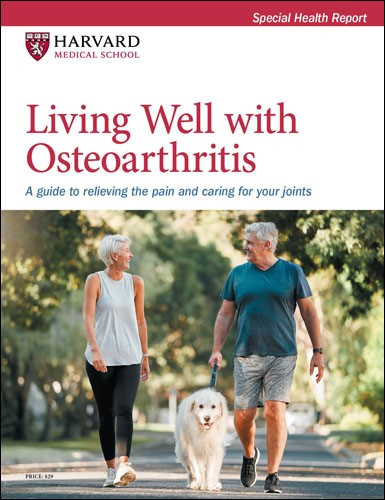Can a knee brace ease arthritis pain?
Knee braces might be able to provide stability, control swelling, and help reduce pain and pressure on the knee.
- Reviewed by Anthony L. Komaroff, MD, Editor in Chief, Harvard Health Letter; Editorial Advisory Board Member, Harvard Health Publishing
 Knee braces might be known best for their benefits after knee surgery: they align and stabilize the joint, giving it time to heal properly.
Knee braces might be known best for their benefits after knee surgery: they align and stabilize the joint, giving it time to heal properly.
But braces might also help you cope with the pain, swelling, and stiffness of knee osteoarthritis—the wearing away of the cartilage that cushions the ends of the bones where they meet in the joint. While evidence about how well braces ease arthritis symptoms is mixed, bracing is a noninvasive strategy that won't hurt to try. The key is understanding your goals for relief. Here are three brace types to consider.
A knee sleeve
One common knee brace is called a sleeve. It's a compressive, stretchy fabric or neoprene tube that you pull over or wrap around your knee. The sleeve extends about six inches above and below the joint.
The snug fit offers many potential benefits: warmth, which loosens up a stiff knee; a sense of support (though it doesn't provide structural support), which might make you feel more confident as you walk; reduced swelling, which eases pain; and possibly a way to prevent flare-ups.
"Compressing the knee helps keep fluid from coming into it. The less swelling, the less your knee will hurt, and the better your knee will move. Reduced swelling also allows muscles that support the knee, such as the quadriceps, to do their job better, so the knee is supported as you walk, squat, or go up or down stairs," says Jim Zachazewski, a physical therapist and athletic trainer with Mass General Brigham Sports Medicine.
An unloader brace
Another type of brace used for knee osteoarthritis is an unloader brace. It's a long frame that fits on top of your leg, from your mid-thigh to your mid-shin. It consists of rigid metal or plastic struts (bars) that go on either side of your leg and horizontal straps to keep the brace in place. The struts hinge at your knee, so you can bend it.
This brace is for people whose arthritis is worse on one side of the knee than the other. "The struts are adjusted to apply force that shifts pressure away from the bad or painful side of the knee, which minimizes pain and swelling," Zachazewski says.
The brace also provides some side-to-side stability for the knee. But the brace can be a little bulky and uncomfortable. Zachazewski recommends wearing a light knee sleeve underneath it to prevent skin irritation and provide joint compression.
Patella tracking braces
 This type of brace combines the approaches of both knee sleeves and unloader braces to reduce knee pain, swelling, and pressure at the kneecap (patella). The kneecap sometimes comes off its track (trochlea) — a groove in the thighbone (femur) that allows the kneecap to move up and down. Misalignment is painful.
This type of brace combines the approaches of both knee sleeves and unloader braces to reduce knee pain, swelling, and pressure at the kneecap (patella). The kneecap sometimes comes off its track (trochlea) — a groove in the thighbone (femur) that allows the kneecap to move up and down. Misalignment is painful.
A patella tracking brace is worn like a knee sleeve. It also has straps or pads that use gentle force to keep the kneecap properly aligned and on track as the knee bends and straightens. This stabilizes the kneecap and redistributes pressure more evenly.
Zachazewski says this brace is especially helpful for going up and down stairs or squatting.
Costs
Costs for knee braces vary. You can find a knee sleeve for about $15 to $75 online or in drugstores. It's not usually covered by insurance.
Health insurance might cover some or all of the costs of an unloader brace or a patella tracking brace, as long as it is prescribed by a doctor and custom-fit by a durable medical equipment dealer that accepts your insurance.
Or you can pay out of pocket for those braces if you buy them online: about $100 to $300 for an unloader brace, and about $35 to $100 for a patella tracking brace.
Getting started
If you're interested in using a knee brace, you can try a knee sleeve on your own. See if it makes a difference and if you feel comfortable wearing it. If it seems to help, ask your doctor if an unloader or a patella tracking brace might work even better. You might need to work with a physical therapist to get used to being active while wearing the bulkier brace.
Zachazewski says you can wear a brace during any activity that places pressure on your knee, such as doing house or yard work, going up and down stairs, shopping, exercising, or just going about your daily activities.
The brace won't heal your knee arthritis, and it's not guaranteed to relieve your symptoms. But for some people, it's an important tool for living with chronic knee pain.
Image: © Knee sleeve: © Med-Ved/Getty Images; unloader knee brace: © delihayat/Getty Images
About the Author

Heidi Godman, Executive Editor, Harvard Health Letter
About the Reviewer

Anthony L. Komaroff, MD, Editor in Chief, Harvard Health Letter; Editorial Advisory Board Member, Harvard Health Publishing
Disclaimer:
As a service to our readers, Harvard Health Publishing provides access to our library of archived content. Please note the date of last review or update on all articles.
No content on this site, regardless of date, should ever be used as a substitute for direct medical advice from your doctor or other qualified clinician.
















